I’m a big fan of tandems. In my many years working as a kayak guide, these two-person boats have been the most consistent MVPs on the water. They haul our gear while leveling the playing field for paddling pairs, families and groups with diverse abilities.
The best tandem kayaks are fast, stable and make it easier to keep everyone together or increase range. Tandems are certainly practical, but they also have an (unfair) reputation for being troublesome to paddle. Ever heard of the “divorce boat?” Yeah, me too. It’s true that tandem paddling benefits from good communication with your kayak partner. But with a bit of practice, most folks I’ve paddled with love the ease that comes with twice the muscle. Some are surprised to discover that a tandem can even double your fun.
Want to take a snack break or cast a line without losing momentum? Tandem power! Get into position for that perfect paddling photo? Tandem power! Share your kayaking passion with a friend, child or significant other? A tandem kayak checks all the boxes.
On a recent guided trip I led, a retired couple delighted me by bringing their own tandem kayak. “We just prefer paddling together,” they explained, “it’s easier to talk and we have more fun.” Indeed, I often heard them giggling or chatting from across the water. On a few breezy occasions, an umbrella appeared for some impromptu sailing. Ten days and more than 100 miles later, they were still laughing.
If you’ve read this far, then I believe a tandem could be for you. The goal of this article is not only to provide direct options for the best kayaks in the category, but to share helpful insights when considering which kayaks best meet your specific needs and aspirations.
Best Tandem Kayaks for 2025: Our Top Picks
- Best Overall Tandem Kayak: Hurricane Santee 140 Tandem
- Best Inflatable Tandem Kayak: Advanced Elements AdvancedFrame Convertible Elite
- Best Performance Touring Tandem Kayak: Delta Traverse 17.5T
- Best Folding Tandem Kayak: Oru Haven
- Best Tandem Fishing Kayak: Hobie Mirage Compass Duo
- Best Tandem Pedal Kayak: Ocean Kayak Malibu Pedal T
Best Tandem Kayak Overall
Hurricane Santee 140
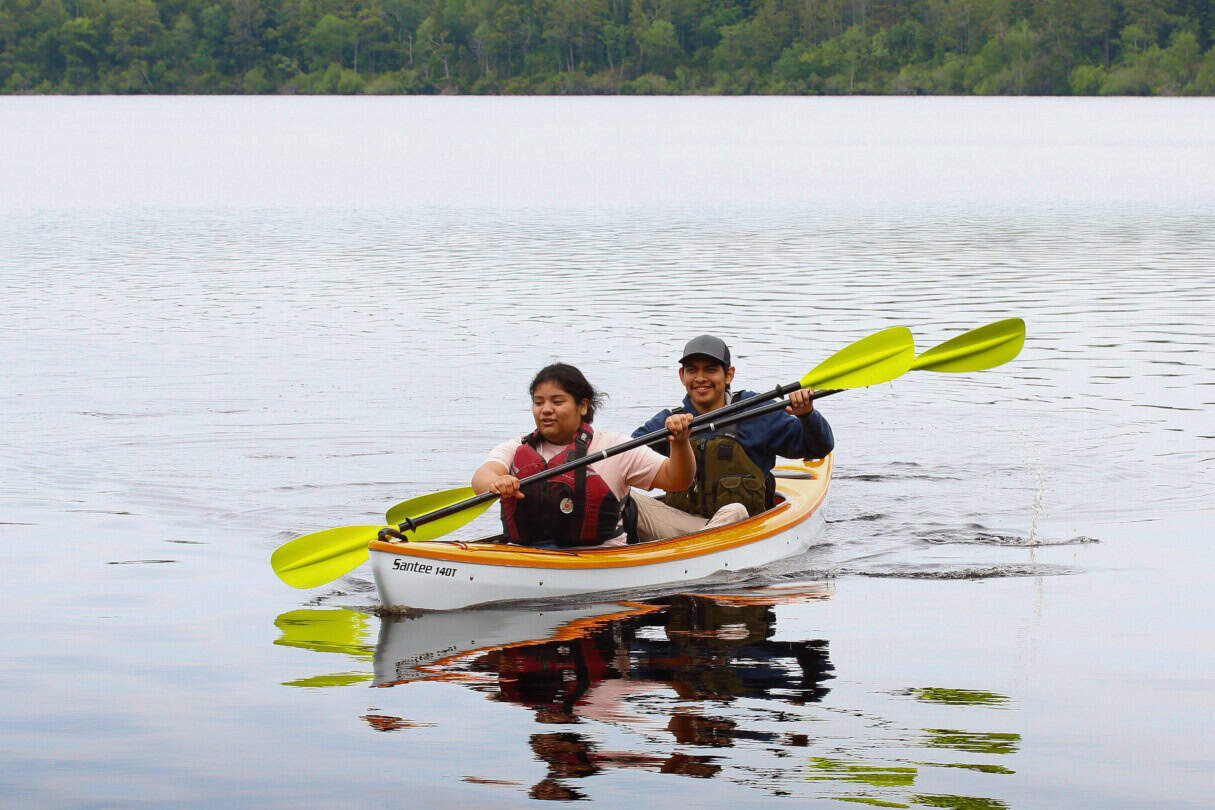
Hurricane Santee 140 Specs
Length: 14’
Width: 31.5”
Weight: 57 lbs
Construction: Thermoformed Trylon ABS plastic
Capacity: 425 lbs
MSRP: $1,699
hurricaneaquasports.com
Buy from:
Why I love it
For paddling with a partner on calm waters and winding rivers, the Hurricane Santee 140 edges ahead of other recreational tandem kayaks with a sleek, lightweight build, comfortable versatility for one or two paddlers, and stable yet responsive performance. Most important to my mind, the Santee is also among the very few recreational sit-inside tandem kayaks to include a critical safety feature: a watertight hatch with a sealed bulkhead (more on why that matters in a moment).
First, though, can I just say that this is one good-looking boat—especially at such an attractive price. For more than 25 years, North Carolina-manufactured Hurricane Kayaks has been thermoforming sheets of ABS plastic into head-turning kayaks. This acrylic-capped laminate is not only much lighter weight and more UV-, warp- and abrasion-resistant than standard polyethylene kayaks, but its lustrous finish gives it composite-kayak looks and performance at a fraction of the cost.
Off the water, the 57-pound Santee 140 is easy to carry and transport on top of a car. Don’t underestimate the value of a lightweight boat—if it’s easy to use, you’ll use it more. On the water, the stiff lightweight hull offers better glide and speed than its rotomolded counterparts, putting longer tours within reach for paddlers of all abilities. The Santee’s streamlined bow and stern, combined with its moderate V-shape, minimal rocker and soft chines prioritize tracking and stability without the added weight and complexity of a rudder.
Behind the rear seat, a 10-inch hatch provides access to a watertight stern compartment. This means plenty of dry storage for your day-tripping gear. It also gives the boat positive flotation if you capsize, making it possible to self-recover in deep water.
Reasons to buy
- 25% lighter than comparable rotomolded recreational sit-inside tandems
- Rear bulkhead for positive buoyancy and flotation, as well as dry storage
- Open cockpit design for easy entry and exit
- Front seat slides back to convert from tandem to solo paddling
Consider another if
- You want a sit-on tandem kayak—look to the Hurricane Skimmer 140 Tandem, currently the lightest tandem sit-on-top on the market
- You’re looking for a lighter weight sit-inside on a tight budget—the Pelican Argo 136XP Tandem is just 10 pounds heavier and half the price
- You need a tandem kayak for specialized uses like fishing, open-water touring or whitewater rivers
Bottom Line
Putting lightweight performance and safety within reach of all paddlers, the Hurricane Santee 140 is a top choice for versatile solo or two-person kayaking on gentle waters.
Best Inflatable Tandem Kayak
Advanced Elements AdvancedFrame Convertible Elite
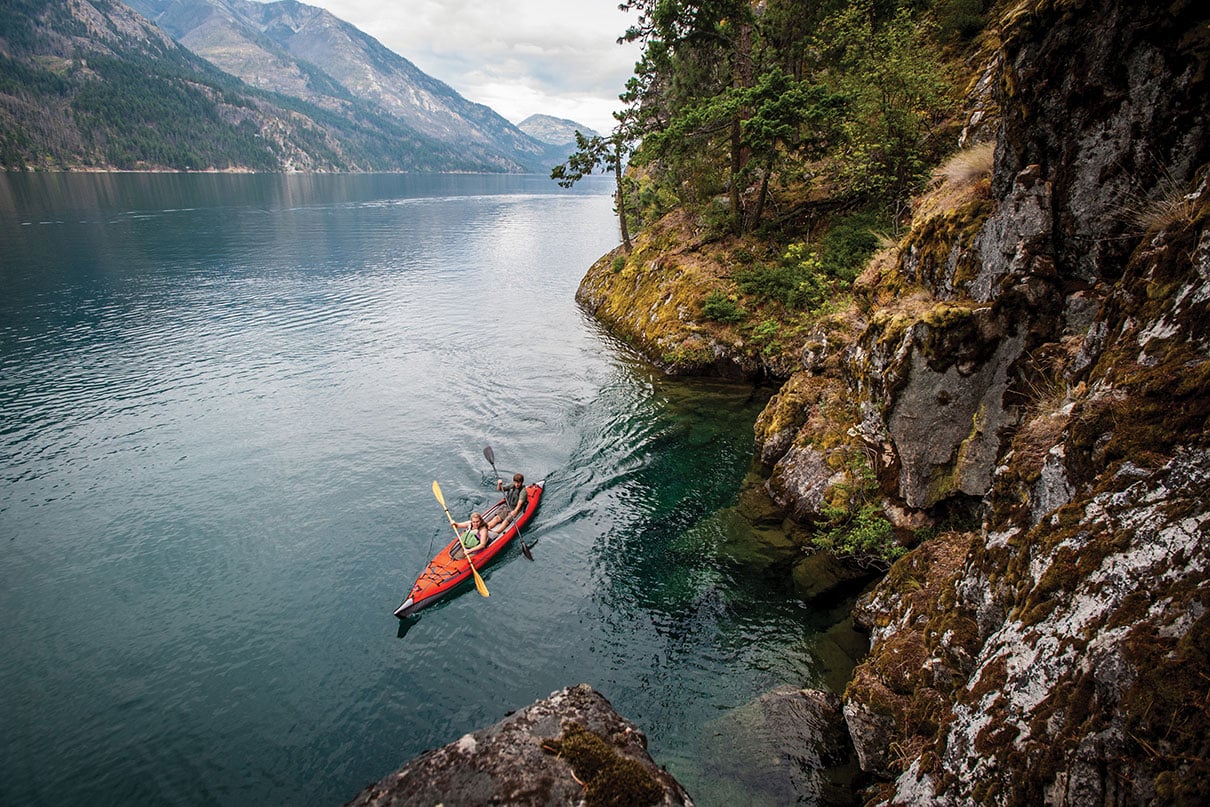
Advanced Elements AdvancedFrame Convertible Elite Specs
Length: 14’11”
Width: 32”
Weight: 52 lbs
Construction: Ripstop polyester outer / PVC internal bladder
Capacity: 550 lbs
MSRP: $1,529.99
advancedelements.com
Buy from:
Why I love it
Two-person inflatable kayaks provide an accessible gateway to paddling that requires far less experience than a hardshell kayak. But the best-in-class combine the ease of inflatables with the performance of rigid boats. When our editors wrote a full review of the Advanced Elements AdvancedFrame Convertible Elite, we applauded “its long waterline and chines, which help enhance speed, tracking and edging ability. These features make the AdvancedFrame Convertible Elite efficient and ideally suited for day trips and touring in friendly conditions.”
What makes the Convertible Elite a touring-capable inflatable tandem kayak is its unique hybrid construction. In addition to air bladders, a pair of aluminum ribs are inserted at the bow and stern to provide a stiff, peaked shape like you would find on a fiberglass or plastic kayak. This helps the bow to efficiently cut through the water.
The floor of the kayak uses a drop-stitch construction for similar rigidity to a paddleboard and efficient gliding across the water. The floor on the Convertible Elite also creates a chined hull, meaning you actually get some edge transition—a rarity on an inflatable paddle craft. The foam seats are comfortable enough for a full day out and raise you to a nice high paddling position.
Factor all of this with the boat’s namesake—a convertible deck that can either be an open cockpit or closed up with the option of a zip-on spray deck—and you have a tandem sit-inside inflatable kayak that can be rolled up and stored in the back of your van, and unfurled to make a crossing against a wind-chopped bay.
Reasons to buy
- Capable touring inflatable with drop-stitched floor
- Tracks well for its class and even has some edging ability
- Convertible from open to closed deck, and solo or tandem paddling
Consider another if
- You prefer fewer components to keep track of
- You are looking for weight savings on your inflatable
- You don’t need a drop stitch floor—then consider the lower-cost non-elite Advanced Elements Convertible
Bottom Line
The Advanced Elements AdvancedFrame Convertible Elite is one of few tandem inflatable kayaks you’ll find enjoyable on a flatwater tour.
Best Performance Touring Tandem Kayak
Delta Kayaks Traverse 17.5T
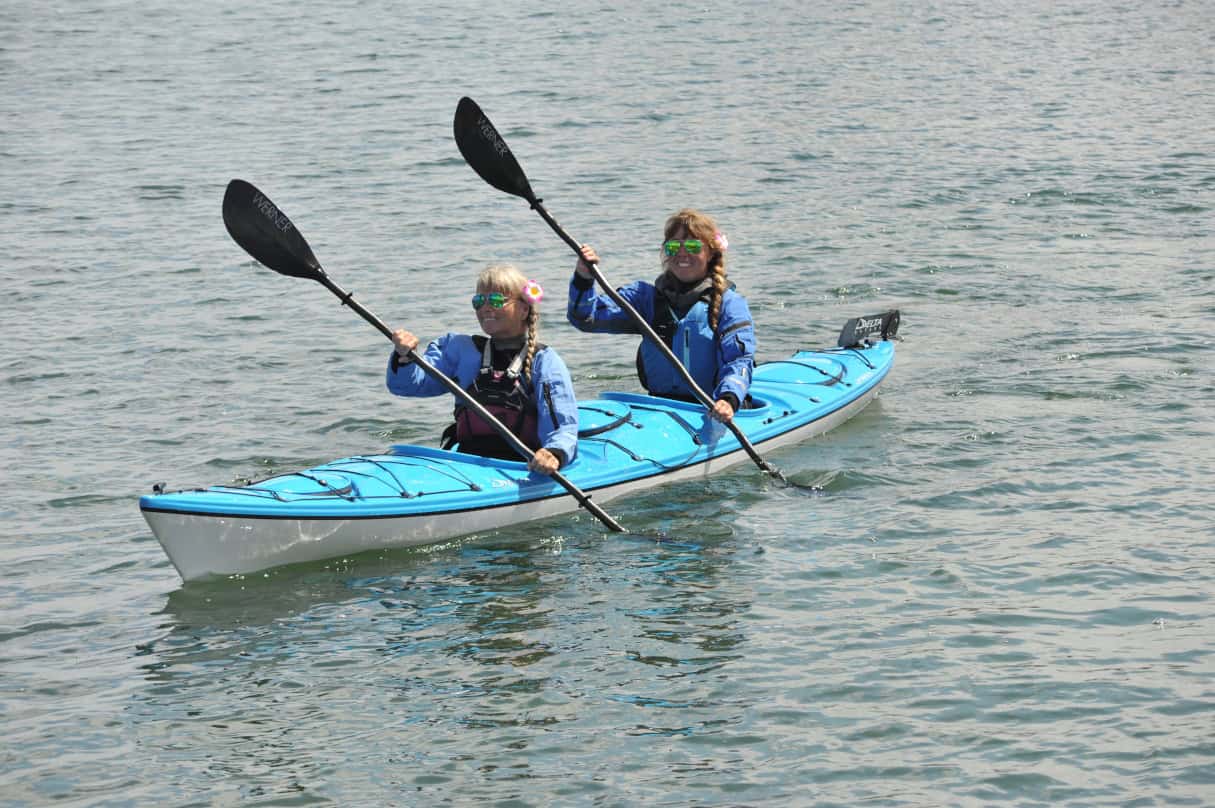
Delta Kayaks Traverse 17.5T Specs
Length: 17’6”
Width: 27.25”
Weight: 70 lbs
Construction: Thermoform plastic
Capacity: 560 lbs
MSRP: $2,850
deltakayaks.com
Buy from:
Why I love it
Where traditional touring tandems offer cargo barge capacity (and maneuverability to match), the compact Delta Kayaks Traverse 17.5T embodies a performance light-touring kayak in a double design.
Delta’s designers finessed more than 191 liters of dry storage and two spacious cockpits into the Traverse’s 17.5-foot length, more typical of solo sea kayaks than touring tandems. As veterans of bicycles and boats built for two know, cockpit proximity is one of the finer points of double design. Too close together, and unsynchronized paddle strokes amount to a jousting match. The 17.5T gets paddler positioning just right.
The shorter waterline also translates to improved responsiveness and lighter hull weight. While hefting a typical touring tandem is a feat of near-Herculean strength, the Traverse tips the scales at a modest 70 pounds—that’s 20- to 50-percent lighter than many competitors. Yet with three sealed storage compartments and large, user-friendly hatches, it’s easy to pack Delta’s tandem for a weekend or week-long adventure. If I were Goldilocks, the Traverse 17.5T hits that sweet spot of “just right” for most of my touring aspirations—not too much and not too little.
For performance alone, the Traverse 17.5T is my top choice for tandem touring. Plus, Delta’s sleek thermoform plastic construction and handy details, such as a shared center day hatch, make it twice as easy to get on board.
Reasons to buy
- Fast and efficient on-water, with plenty of cargo capacity for longer trips
- Easy to adjust seat system enables paddlers of different sizes and weights to dial in fit
- Lightweight thermoform construction is attractive, durable and budget-friendly
Consider another if
- You need an expedition-size tandem for your upcoming mission around Cape Horn
- Your touring ambitions are limited to short trips on sheltered inland waters
Bottom Line
For committed paddling partners, the Delta Traverse 17.5T is a fantastic all-around tandem for weekend adventures and multi-day tours.
Best Folding Tandem Kayak
Oru Haven
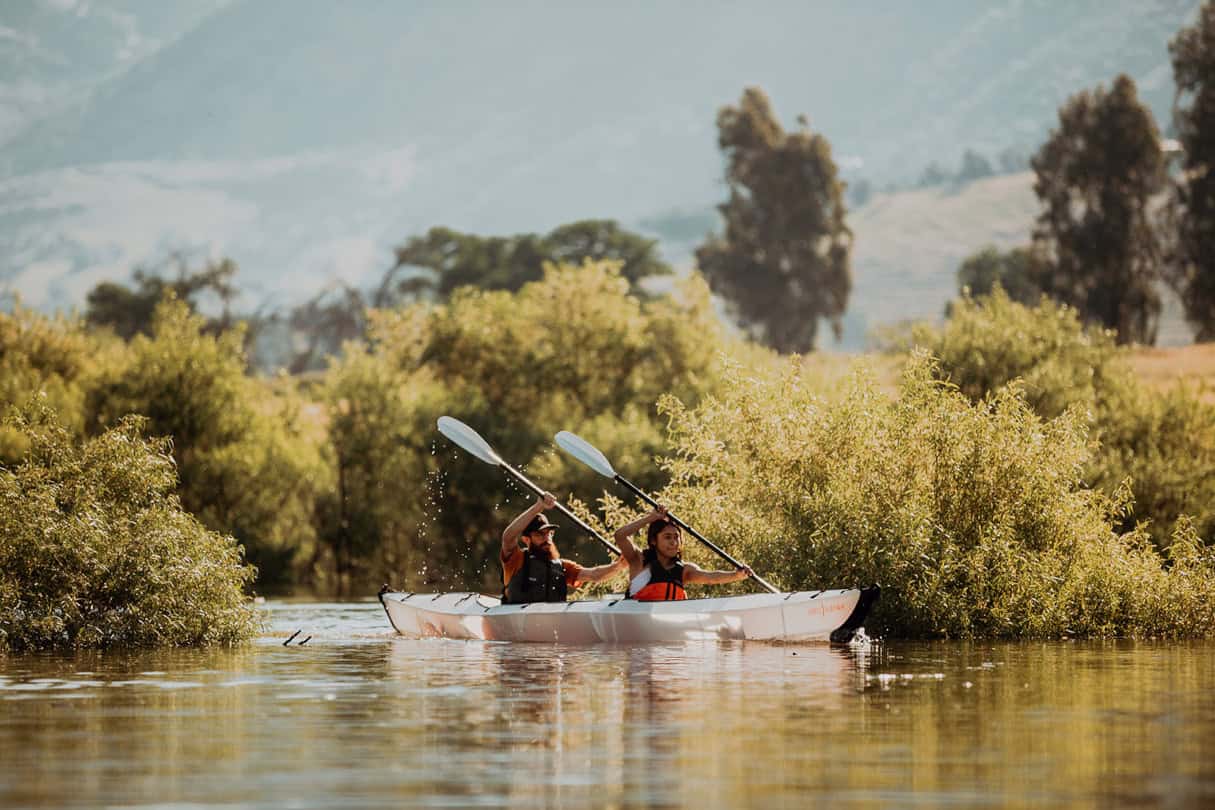
Oru Haven Specs
Length: 16’1”
Width: 33”
Weight: 41 lbs
Construction: Folding 5mm double-walled polypropylene
Capacity: 500 lbs
MSRP: $1,999
orukayak.com
Buy from:
Why I love it
Folding kayaks generally fall into two categories. Those designed for intrepid paddlers intent on reaching the world’s most remote places. And those designed for portable convenience, making paddling accessible to anyone. The latter aren’t just more practical for the vast majority of recreational kayakers, they’re also a great deal more affordable.
Enter Oru Kayaks. When Paddling editor-at-large Tim Shuff hit the water with his young son for a full review of the Oru Haven, he praised the origami-inspired craft’s ease-of-assembly, durable hull, lightweight portability and, above all, versatility. The Haven goes from suitcase to shore in just 15 minutes. The hull has a 10-year UV treatment and is rated for 20,000 folds—theoretically, more than 50 years of daily paddling and folding.
Performance-wise, the Haven is best suited to friendly waters and performs as you’d expect for a wide, open-cockpit recreational design. “Stability is rock solid, its lightweight hull responds quickly to every paddle stroke, and it tracked straight and stayed dry even in a stiff breeze with small whitecaps,” observed Shuff.
Versatility is the Haven’s key advantage, converting quickly from a tandem to a single by merely clipping the seat and footrest to different attachment points. There’s plenty of room for two adults or various combinations of gear, kids and dogs. Shuff says anyone considering a traditional open-cockpit tandem recreational kayak should give the Oru Haven a serious look. For not much more money, the user-friendly Haven is half the weight with the bonus of unprecedented packability and storage.
Reasons to buy
- The 16-foot-long kayak packs down to the size of luggage
- Intuitive to set up within 15 minutes
- Super stable and lightweight
Consider another if
- Your aspirations with a folding kayak involve open water crossings and remote destinations—in this case, check out the Klepper Aerius 545 Expedition
- You plan to tackle whitewater where an inflatable would be a better packable choice
Bottom Line
If you’re in search of a unicorn recreational tandem kayak to paddle calm lakes and bays or slow rivers, while being able to store under a bed, the Haven is the folding kayak you need.
Best Tandem Kayak for Whitewater
AIRE Tributary Tomcat Tandem
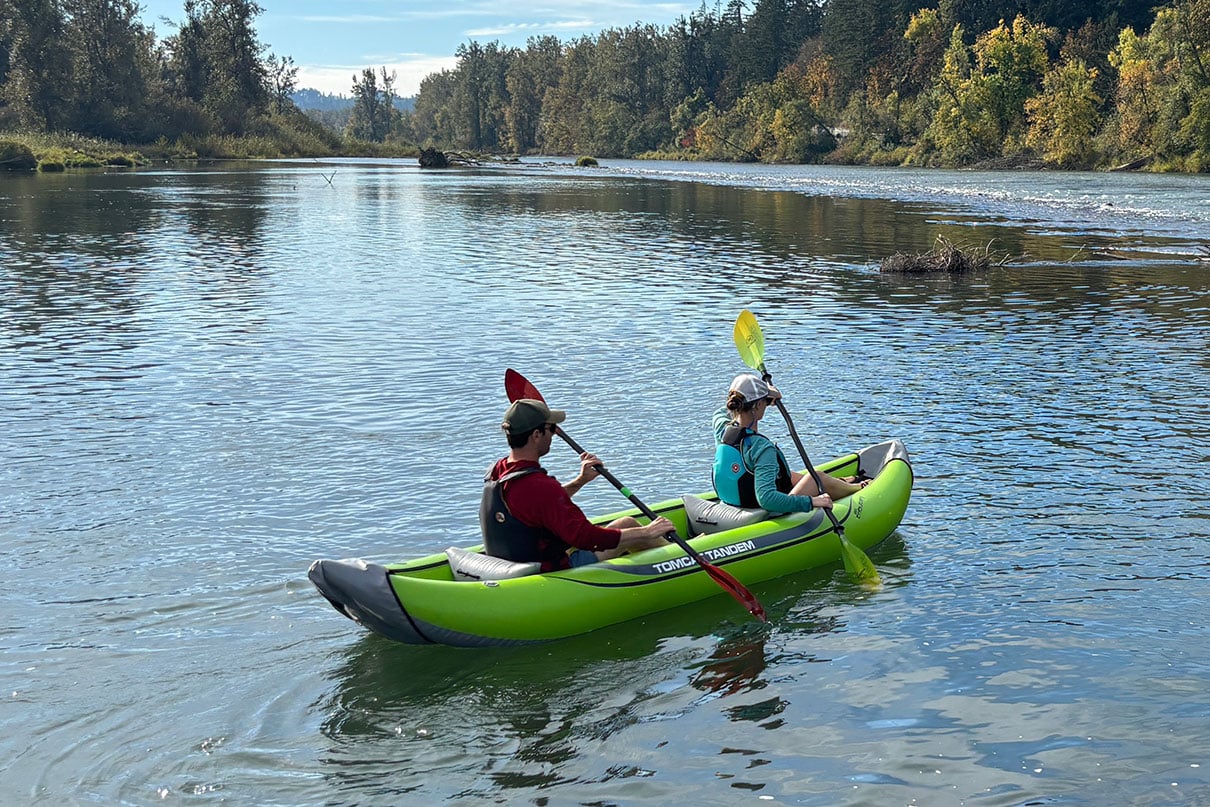
AIRE Tributary Tomcat Tandem Specs
Length: 12’6”
Width: 38.5”
Weight: 44 lbs
Construction: Inflatable PVC
Capacity: 500 lbs
MSRP: $1,200
aire.com
Buy from:
Why I love it
When Paddling Magazine digital editor Joe Potoczak reviewed the AIRE Tributary Tomcat Tandem, he described the design as a trusted river-running inflatable with two decades of whitewater use proving the boat’s merit.
Inflatable kayaks shine on rivers, where moving water means flips and swims are par for the course. These boats make the sport more approachable by being wide, stable, buoyant and easier to scramble back aboard, allowing more people to ride through wave trains and drift through pools to take in the scenery. Our editors confirmed the Tomcat Tandem’s torpedo shape and rockered nose plows over rapids, punches through waves and holes and remains stable. It can be paddled as a tandem or solo kayak and the outfitting is simple yet comfortable.
AIRE uses an innertube-like bladder inside the Tomcat Tandem’s outer PVC shell that can be easily replaced. No matter how tough a tube is, when you’re running whitewater, a puncture can happen. AIRE’s unique construction means you can simply unzip any of the Tomcat’s three tubes, remove and repair or replace the vinyl chamber. Voila! The boat is back to work.
AIRE has a collection of respected tandem designs, including the bigger Outfitter II and sleek sporty Lynx II. The Tomcat Tandem isn’t too dissimilar from either of these designs, while being just half the price.
Reasons to buy
- Value price whitewater tandem inflatable with the reputation of an AIRE design
- Tough PVC outer construction with replaceable air bladders
- Rolls up to fit in a hatchback or closet for transport and storage
Consider another if
- A hardshell plastic kayak better suits the performance you are after—in this case, check out the Jackson Kayak Dynamic Duo
- You paddle class I–II whitewater and prefer a smaller outer tube diameter for easier paddle strokes and self-rescue
Bottom Line
The Tomcat Tandem’s sturdy PVC build and proven design make it a reliable and affordable choice for aspiring whitewater paddlers.
Best Tandem Fishing Kayak
Hobie Mirage Compass Duo
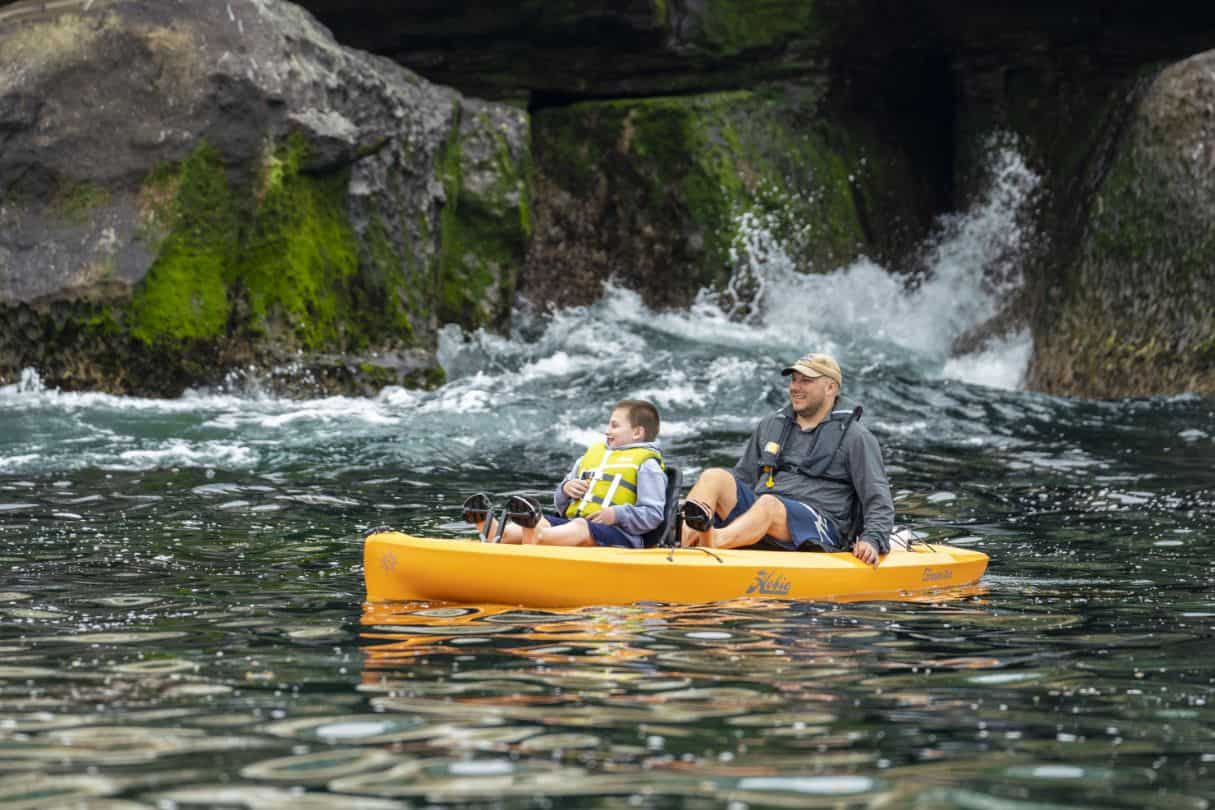
Hobie Mirage Compass Duo Specs
Length: 13’6”
Width: 35”
Weight: 92 lbs (127 lbs fully rigged)
Construction: Rotomolded polyethylene
Capacity: 475 lbs
MSRP: $3,799
hobie.com
Buy from:
Why I love it
The pedal drive may just be the biggest evolution in the history of kayak fishing. Try fishing a tight stream or along overhanging estuaries without a pedal drive and frustration quickly mounts as you fumble with a paddle in one hand and a rod in the other. Sure, paddling tandem means partners can take turns casting and paddling, but that means you’re only fishing half the time.
Thanks to pedal drives, the kayaking part of fishing became nearly hands-free, allowing you to focus on what you really hit the water to do—fight fish. Hobie’s MirageDrive led the way in this evolution and continues to dominate the world of sit-on fishing kayaks.
Our editor at Kayak Angler, Ric Burnley, has reviewed just about every fishing kayak in existence. He test drove the Mirage Compass when it first debuted, proclaiming it fast, responsive and refreshingly lightweight compared to other pedal-drive fishing kayaks. Hobie’s upgraded MirageDrive pedal system puts cruising and trolling speeds of up to 5 mph within reach and the hull cuts through wind, wakes and chop. The manageable hull width means paddling the Compass Duo is still an option, if needed.
The Compass Duo is equipped with Hobie’s MirageDrive 180, delivering a smooth and efficient ride for two in both forward and reverse. The rugged plastic hull is considerably sleeker and lighter than comparable pedal-drive fishing kayaks, maximizing speed and stability while reducing drag. Even better, this pedal-powered fishing tandem is loaded with angler-ready features and—in a market crowded with bass boat-worthy price tags—remarkably budget-friendly.
Reasons to buy
- Hobie’s proven MirageDrive pedal power
- Integrated H-Tracks for flexible accessory mounting, fishfinder-ready, loads of above and below deck storage
- Plenty of flat deck area and stability for standing and casting
Consider another if
- You want an ultralight tandem pedal-drive fishing kayak that also packs into a bag for travel and storage—in this case, check out the Hobie Mirage iTrek 14 Duo
- You are looking for a paddle-powered tandem fishing kayak
Bottom Line
The Hobie Mirage Compass Duo offers anglers a well-designed tandem fishing kayak with a proven drive system and an angler-ready platform you can fully customize from the ground up.
Best Pedal Tandem Kayak
Ocean Kayak Malibu Pedal T
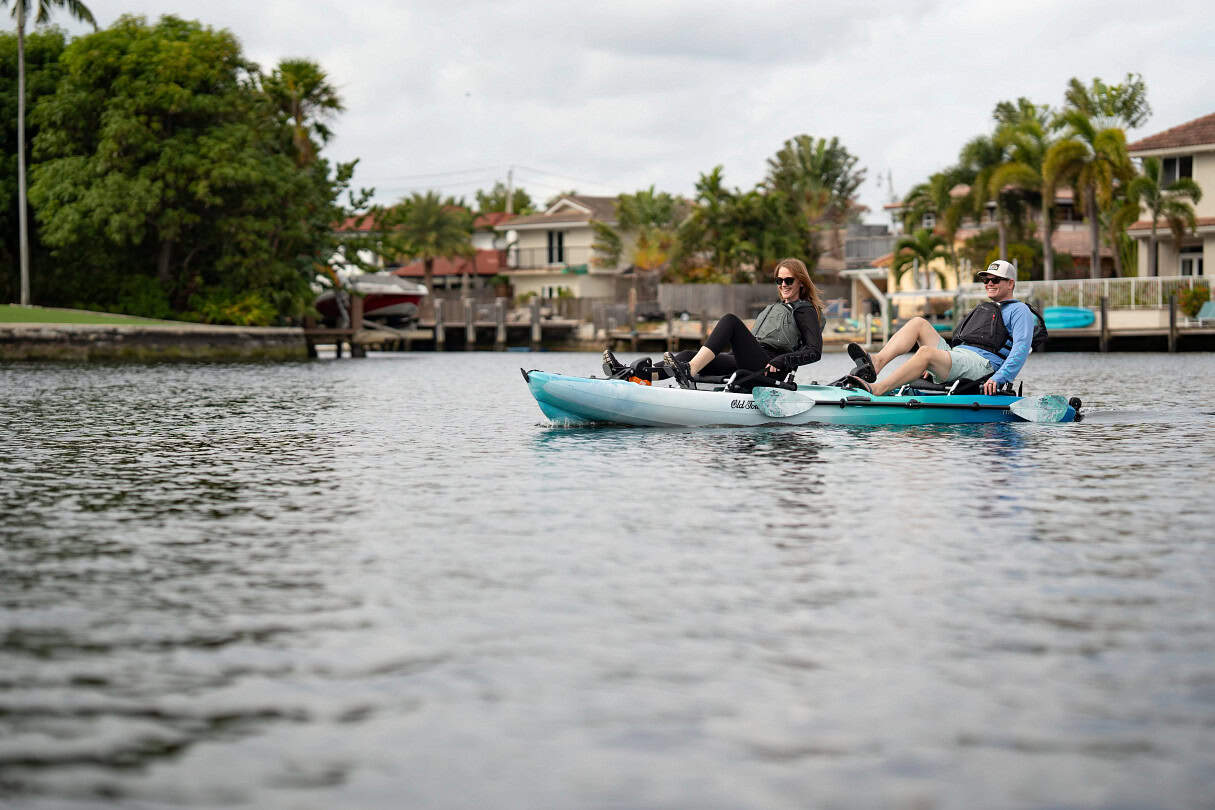
Ocean Kayak Malibu Pedal T Specs
Length: 13’6”
Width: 36”
Weight: 154 lbs (fully rigged)
Construction: Rotomolded polyethylene
Capacity: 567 lbs
MSRP: $3,999.99
oldtownwatercraft.com
Buy from:
Why I love it
First of all, why a pedal kayak? Pedal-drive kayaks offer some unique advantages over more traditional paddle kayaks—like hands-free kayaking, increased range and stability, and the ability to enjoy both leg propulsion and paddle power from the same kayak. Additionally, the increased efficiency of pedal power allows manufacturers to build larger, more stable kayaks—appealing for families, anglers and recreational kayakers who want a boat that doesn’t feel wobbly in the water.
The Ocean Kayak Malibu Pedal T from Old Town pairs slick and efficient pedal drives with their flagship recreational kayak hull. The Malibu is a classic sit-on-top kayak: highly stable and easy to use, with an open deck design and comfortable outfitting. The pedal drive works like a fixed-gear bicycle, with the user’s legs turning a prop to move the kayak forward or reverse. A hand-controlled rudder aids with steering, and the comfortable frame seats offer a higher vantage point for fishing.
When our editors reviewed the Ocean Kayak Malibu, they hailed it as an innovator in the realm of recreational kayaking—first for introducing the world to the sit-on-top style of recreational kayak, and then adding an award-winning pedal drive.
Reasons to buy
- Intuitive forward-and-reverse pedal drive is just like riding a bike
- Fishing-ready with accessory tracks, rod holders and ample gear storage
- Deluxe seating for all-day comfort
Consider another if
- You want a simple, lighter-weight, inexpensive recreational kayak—Ocean Kayak’s Malibu Two paddle kayak may be a better fit
- You’re looking for a budget pedal-drive tandem kayak
Bottom Line
Built in Maine and backed by a lifetime hull warranty, there’s good reason the Ocean Kayak Malibu is the best-selling OG of recreational sit-on-top kayaks.
Best Modular Tandem Kayak
Point 65 Mojito Tandem

Point 65 Mojito Tandem Specs
Length: 15’9”
Width: 29”
Weight: 86 lbs
Construction: Rotomolded polyethylene
Capacity: 440 lbs
MSRP: $2,489
point65.com
Buy from:
Why I love it
Modular kayaks offer a functional middle ground between packable kayaks and traditional hardshell kayaks. Like inflatable and folding kayaks, the appeal of modular kayaks lies in their easy transport and storage. There are some key differences, however. Folding and inflatable styles are lighter weight, pack down smaller and can be very low cost. But only modular kayaks provide the same performance and feel as rigid plastic or composite designs.
There’s more: modular tandem kayaks like the Point 65 Mojito are actually two boats in one. When the urge strikes, you can leave the second cockpit section at home and enjoy the scaled-down size and responsive paddling of a true solo kayak. Plus, there’s almost zero set-up time at the launch. The Point 65 Mojito snaps together like a set of Legos in just seconds.
Point 65 is a Swedish brand that began pioneering plastic sectional kayaks over 15 years ago. They offer half a dozen sit-on and sit-inside modular kayak models available in North America for recreational users and anglers. The Mojito is a versatile sit-on-top design that’s stable and easy to use solo or tandem. Snap the two end sections together for a compact 10’10” single seater weighing just 57 pounds. Add the middle section to switch to tandem paddling.
What most impresses me about Point 65’s modular kayak is it doesn’t feel like a take-apart kayak. Once I click together the snowboard binding-style ratchet straps—two at each section joint—there’s no hull flex or added drag. The Mojito feels quick, capable and built to last—just like my favourite hardshells.
Reasons to buy
- Hardshell durability and performance with near-zero assembly time
- Tri-hull and steerable keel rudder for superb stability and tracking
- Waterproof hatches and plenty of on-deck storage
Consider another if
- You want to take longer trips on more exposed waters—the modular Point 65 Mezcal GTX touring tandem is a better choice
- Cost is no object and premium ultralight touring performance is a must—I recommend Stellar’s ST19 Modular Tandem
- You’re looking for a budget or backpack-sized portable tandem kayak
Bottom Line
The Point 65 Mojito offers hardshell performance in an easy-to-store sectional kayak that effortlessly switches between tandem and solo use.
Tandem kayak buying advice
Tandem kayaking can look very different depending on where and how you paddle, but if you can only own one kayak, buy the boat that you will enjoy on the waters you paddle most of the time. For example, a performance touring tandem probably isn’t the best choice if you mostly enjoy short outings on your local bay, wetland or river. Since tandem kayaks tend to be larger and heavier than similar solo kayaks, you also want a tandem kayak that meets your storage and transport requirements. Also, buy the lightest kayak your budget allows—trust me, you’ll use it more.
If your local waters consist of sheltered bays, quiet rivers and inland lakes, look to a compact recreational tandem kayak or inflatable tandem kayak that is easy to store and transport and encourages you to get out more often. Sit-on tandems and inflatable two-person kayaks are great choices for warmer waters. Many of these models offer flexible seating that allows you to easily convert from tandem to solo paddling. This flexibility also lends itself to paddling with a larger dog or children aboard, and fishing from your kayak. Look to sit-inside recreational kayaks for more protection in colder waters and climates. Many tandems of this style allow you to wear spray decks to keep out splashing waves.
If you dream of exploring wilderness coastlines with your paddling partner, it may be time to invest in a touring tandem equipped with enclosed cockpits, sealed hatches, bulkheads, rudder and perimeter decklines. These important safety features are required for a tandem kayak capable of making those extended journeys.
If you’re deciding whether to buy a tandem kayak or a canoe, where you plan to paddle is once again the most important consideration. Canoes offer excellent capacity for hauling gear, pets and people (it’s easy to sit a third paddler in the center) on sheltered waters. Canoes are also designed to be carried comfortably on the paddler’s shoulders, making them ideal for routes where you’ll need to carry overland, such as between small lakes or around rapids. The higher seats let paddlers switch between sitting and kneeling, but this also puts their center of gravity higher, which can make things feel “tippy.” For more exposed waters where windy and wavy conditions are possible, a tandem kayak will feel more stable and be easier to control.
Budget is another important consideration when shopping for a tandem kayak. Whether you are looking to buy a recreational, inflatable or fishing tandem kayak, choosing a model from a reputable kayak brand will ensure you get a boat that’s good value while still providing great durability, performance, comfort and longevity. Research paddlesports stores in your area and consider buying from a local retailer rather than shopping online or at a big box store. Dedicated paddlesports shops have experienced staff that can help you select the best tandem kayak for your needs.
Best tandem kayak brands
- Hurricane Kayaks
- Wilderness Systems
- Delta Kayaks
- Current Designs
- Boréal Design
- Old Town
- Perception
- Stellar Kayaks
- Norse Kayaks
- Point 65 Kayaks
- Riot Kayaks
- Liquidlogic
- Pelican
- Oru Kayak
- AIRE
- Sea Eagle
- NRS
- Advanced Elements
- Hobie
- Jackson Kayak
- Nyce Kayaks
- Epic Kayaks
How we tested
To create this list of the best two-person kayaks we took popular boats available today out on our favorite local waterways, as well as gathered the feedback of editors and contributors and their reviews conducted over years of editorial coverage.
Why trust us
As a longtime Paddling Magazine contributor, former Adventure Kayak editor, and wilderness kayak guide and coach for over two decades, I’ve had the pleasure of paddling with a tremendous variety of people and paddle craft. Tandem kayaks have been my choice for both epic endurance challenges and laidback explorations with loved ones, providing me firsthand insights into the versatility and limitations of two-person kayaks.



